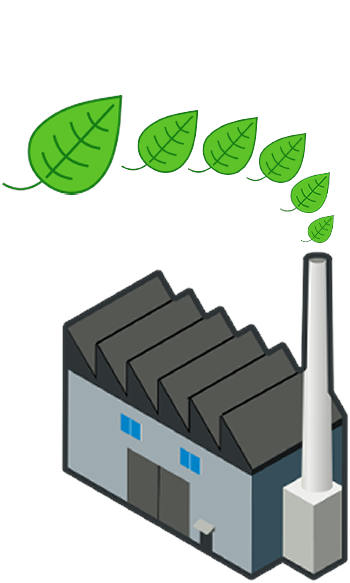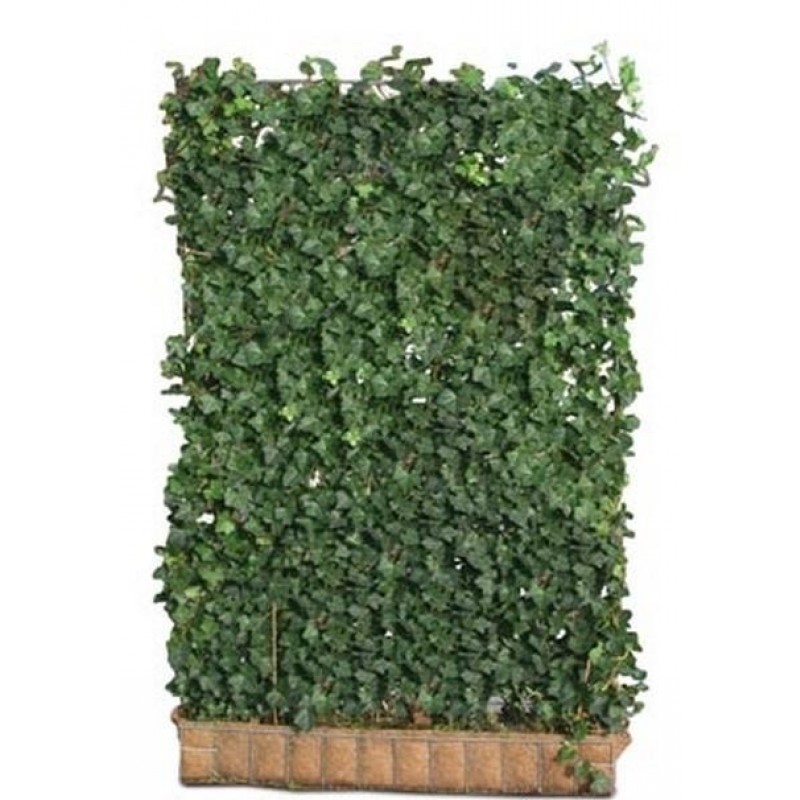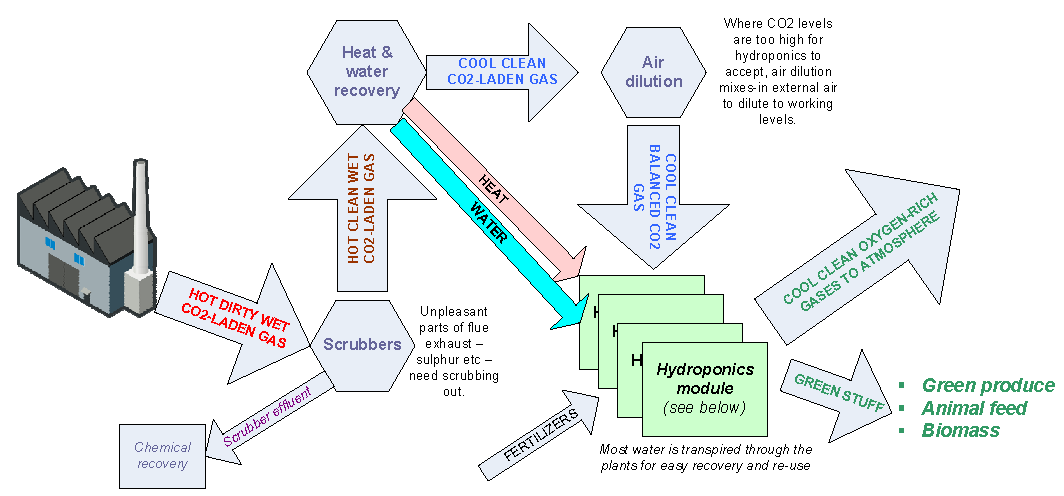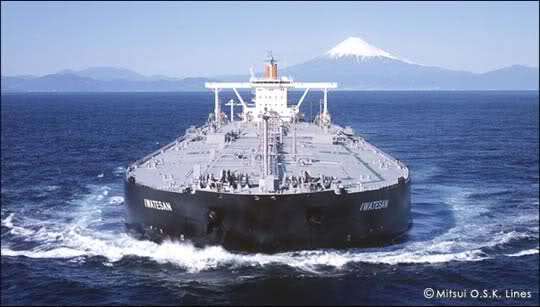Nice idea but can plants REALLY do
this?
What if you're short of
water?
Growing stuff takes water. Lots and lots of
water. So this may look unworkable in drier areas. It
isn't.
Because in conventional agriculture, most of the water you apply
(99.24% in the above Hedera helix example) is
wasted - it transpires straight to
atmosphere so it's gone, so you need to get more.
HCC is a closed environment, meaning the transpired water
is condensed back out and re-used.
But where do we get the water from in the first place? From
basic chemistry. We know burning carbon fuel releases lots of CO2 -
but it also releases lots of water.
Here's the equation for wood burning, but other fuels are
broadly similar:
C6H12O6
|
+
|
6 O2
|
=
|
6 CO2
|
+
|
6 H2O
|
So when HCCAS recovers the heat from the flue
gas we'll ALSO condense out LOTS of water.
There's another reason to reduce water vapour
emission.
Recent science identifies rising
water vapour as magnifying global warming - scavenging water
this way dramatically cuts water vapour emission to
atmosphere.
SO now we're reducing CO2, making
food, biomass, or
biochar, making O2, providing
resilient agriculture AND reducing water
vapour's global warming impact. And can do so profitably,
producing funds for the local economy or more environmental
projects.
That's pretty cool for a few plants.
Won't HCCAS cost as much as CCS - or more
- to implement...?
Highly doubtful. Think about it: CCS needs
complex pressurized long-distance transport infrastructure;
HCCAS doesn't.
CCS demands large-scale secure "burial" sites which subsequently
need to be guarded and monitored,
forever; HCCAS
doesn't.
CCS consumes a lot of energy doing what it does, so you actually
need to produce lots MORE energy just to CCS the CO2 that you've
made from, er, producing the energy to operate the CCS... go
figure. HCCAS doesn't.
CCS presents a high-value attractive terrorist target with a
very long and largely unprotectable perimeter (including 1000s of
miles of pipeline); HCCAS doesn't.
BEST OF ALL HCCAS can reach all the places in
the world CCS can't (economically) get to, it's infinitely
flexible, it feeds people,
improves our air, encourages
re-forestation (and biodiversity)
and it's greener than a very green thing so -
unlike CCS - will be welcomed by local populations
rather than resisted. That should also help re-invigorate
rather-jaded levels of public enthusiasm for green
projects.
And because HCCAS is all the same, once the first is built
subsequent builds are easy. Extending that logically to
mass-produced modules means we can do lots and LOTS of
installations very, very fast and very cost-effectively. According
to the cost analysis done for the
HCCAS 2016 MIT SOLVE entry HCCAS can even be
cash-positive.
And that's something CCS will never be.
Here's another interesting thing about CCS.
Trying to find a way - any way - to improve its dire economics, a
use has been found for the CO2 the CCS has buried. Any guesses
what? You'll love this... it's used for EOR.
"EOR"? Yep - Enhanced Oil Recovery. The CO2 is
pushed down dying oil wells to squeeze out more oil. The best use CCS has for its captured CO2
is extracting MORE fossil fuels to make MORE CO2. Yep,
seriously. D'uh.
Ask yourself:
- Would you rather spend
money ONCE on something that keeps
on
GIVING BACK, like
HCC?
- Or would you rather
KEEP ON spending lots of money on
something that will keep on
TAKING - forever - like CCS?
Use brownfield = save
greenfield
HCC doesn't need fertile soil, a sunny aspect, the right
rainfall, or much else.
It doesn't need to be in an attractive area with shops and
schools, or handy for the motorway.
So it's ideal for brownfield site that's
unworkable for conventional agriculture and unsuitable for people,
meaning it frees-up greenfield land for people,
reforestation, or nature. Don't know how that pans-out financially,
but I'm pretty confident how it pans out rationally.
Hang on - aren't we
talking 1000s of tonnes of plants a day?
Yep. The planned
Drax 100% biomass-fuelled 300MW power station was expected to
burn 1.4 million tonnes
of
biomass annually (that's just under 4000 tonnes a
day). So, for an emitter that size, yes.
BUT think that through - we're ALREADY planning to handle that
much biomass, shipping it in. So there's nothing inherently scary
about handling big numbers of biomass. Now imagine if we could MAKE
the biomass locally instead of shipping it in,
converting emitted CO2 back into more biomass right there on site.
We won’t achieve 100% capture, but if we assume just
30% then as well as releasing 1000's of tonnes of
oxygen, in one year HCC on this installation would
save:
- all the cost and emissions created by shipping
30% of 1.4 M tonnes - that's 420,000 tonnes - of biomass (most
UK consumption is sourced from overseas)
- the global warming impact of the 30% of CO2
recovered; if we assume biomass to be around 40% carbon, we have of
the order of 40% of the recovered
30% of 1.4M = 168,000 tonnes of
carbon (that's roughly 620,000 tonnes of
CO2).
- The agricultural land you'd need to GROW
420,000 tonnes of biomass. So it could be used for reforestation,
or for people, or...
If your emitter can't use biomass - say you
have a gas-fired plant or a coal- or oil-fired cement works - HCC
can produce food instead, or can produce a
fast-growing crop for biochar to sequester carbon
directly.
Quickly, cheaply, flexibly. Did I mention it
makes O2 as well? And the food HCC makes - really efficiently -
means you free-up 1000s of acres of conventional agriculture, so
you can re-forest that land and those trees will near-permanently
sequester carbon (as well as aiding biodiversity, greatly improving
our environment, and providing a source of green building
materiel).
Biomass, biochar, or food, if I'm right about HCC we can spend a
few billion implementing it to achieve
permanent
carbon reduction AND
all these other benefits.
Or, we can spend many trillions
re-locating
populations, draining floods and starving from drought while
we watch the Earth turn into Venus.
Here's an overview of
HCCAS:





